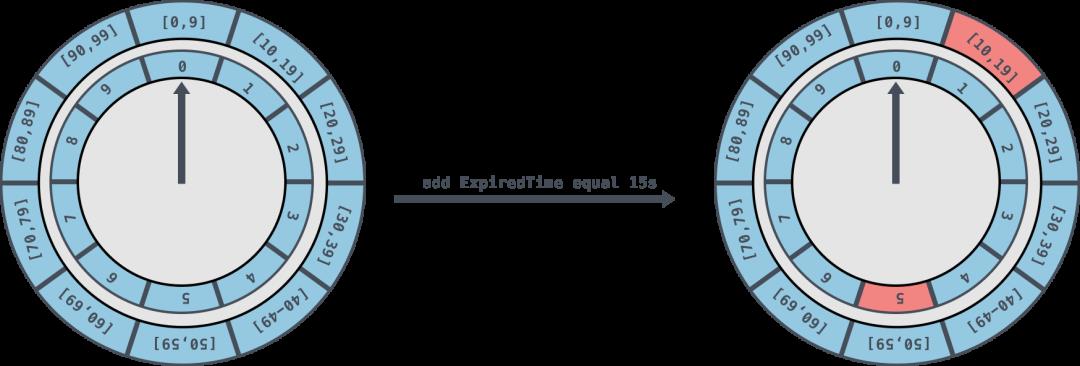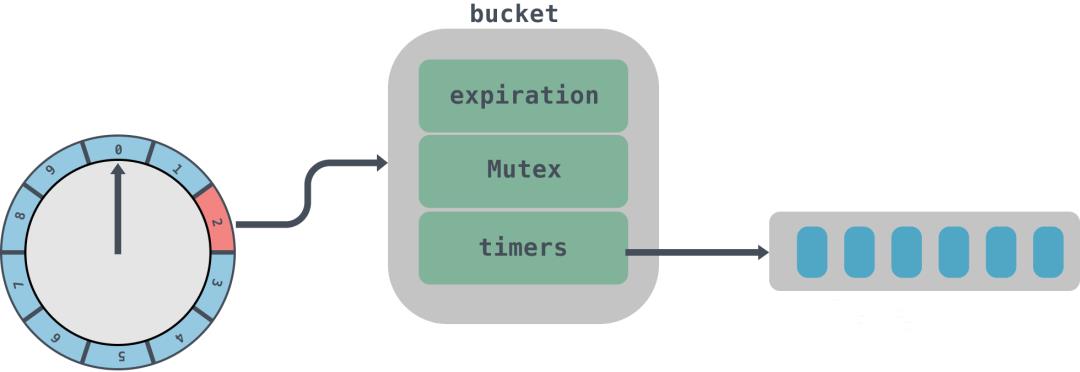Go语言中时间轮的实现
Posted CSDN
tags:
篇首语:本文由小常识网(cha138.com)小编为大家整理,主要介绍了Go语言中时间轮的实现相关的知识,希望对你有一定的参考价值。

介绍
简单时间轮



层级时间轮


代码实现
-
时间轮的时间格中每个链表会有一个 root 节点用于简化边界条件。它是一个附加的链表节点,该节点作为第一个节点,它的值域中并不存储任何东西,只是为了操作的方便而引入的; -
除了第一层时间轮,其余高层时间轮的起始时间(startMs)都设置为创建此层时间轮时前面第一轮的 currentTime。每一层的 currentTime 都必须是 tickMs 的整数倍,如果不满足则会将 currentTime 修剪为 tickMs 的整数倍。修剪方法为:currentTime = startMs - (startMs % tickMs); -
Kafka 中的定时器只需持有 TimingWheel 的第一层时间轮的引用,并不会直接持有其他高层的时间轮,但每一层时间轮都会有一个引用(overflowWheel)指向更高一层的应用; -
Kafka 中的定时器使用了 DelayQueue 来协助推进时间轮。在操作中会将每个使用到的时间格中每个链表都加入 DelayQueue,DelayQueue 会根据时间轮对应的过期时间 expiration 来排序,最短 expiration 的任务会被排在 DelayQueue 的队头,通过单独线程来获取 DelayQueue 中到期的任务;
结构体
type TimingWheel struct {
// 时间跨度,单位是毫秒
tick int64 // in milliseconds
// 时间轮个数
wheelSize int64
// 总跨度
interval int64 // in milliseconds
// 当前指针指向时间
currentTime int64 // in milliseconds
// 时间格列表
buckets []*bucket
// 延迟队列
queue *delayqueue.DelayQueue
// 上级的时间轮引用
overflowWheel unsafe.Pointer // type: *TimingWheel
exitC chan struct{}
waitGroup waitGroupWrapper
}
type bucket struct {
// 任务的过期时间
expiration int64
mu sync.Mutex
// 相同过期时间的任务队列
timers *list.List
}
type Timer struct {
// 到期时间
expiration int64 // in milliseconds
// 要被执行的具体任务
task func()
// Timer所在bucket的指针
b unsafe.Pointer // type: *bucket
// bucket列表中对应的元素
element *list.Element
}

初始化时间轮
func main() { tw := timingwheel.NewTimingWheel(time.Second, 10) tw.Start() }func NewTimingWheel(tick time.Duration, wheelSize int64) *TimingWheel { // 将传入的tick转化成毫秒 tickMs := int64(tick / time.Millisecond) // 如果小于零,那么panic if tickMs <= 0 { panic(errors.New("tick must be greater than or equal to 1ms")) } // 设置开始时间 startMs := timeToMs(time.Now().UTC()) // 初始化TimingWheel return newTimingWheel( tickMs, wheelSize, startMs, delayqueue.New(int(wheelSize)), )}func newTimingWheel(tickMs int64, wheelSize int64, startMs int64, queue *delayqueue.DelayQueue) *TimingWheel { // 初始化buckets的大小 buckets := make([]*bucket, wheelSize) for i := range buckets { buckets[i] = newBucket() } // 实例化TimingWheel return &TimingWheel{ tick: tickMs, wheelSize: wheelSize, // currentTime必须是tickMs的倍数,所以这里使用truncate进行修剪 currentTime: truncate(startMs, tickMs), interval: tickMs * wheelSize, buckets: buckets, queue: queue, exitC: make(chan struct{}), }}
启动时间轮
func (tw *TimingWheel) Start() { // Poll会执行一个无限循环,将到期的元素放入到queue的C管道中 tw.waitGroup.Wrap(func() { tw.queue.Poll(tw.exitC, func() int64 { return timeToMs(time.Now().UTC()) }) }) // 开启无限循环获取queue中C的数据 tw.waitGroup.Wrap(func() { for { select { // 从队列里面出来的数据都是到期的bucket case elem := <-tw.queue.C: b := elem.(*bucket) // 时间轮会将当前时间 currentTime 往前移动到 bucket的到期时间 tw.advanceClock(b.Expiration()) // 取出bucket队列的数据,并调用addOrRun方法执行 b.Flush(tw.addOrRun) case <-tw.exitC: return } } })}
func (tw *TimingWheel) advanceClock(expiration int64) {
currentTime := atomic.LoadInt64(&tw.currentTime)
// 过期时间大于等于(当前时间+tick)
if expiration >= currentTime+tw.tick {
// 将currentTime设置为expiration,从而推进currentTime
currentTime = truncate(expiration, tw.tick)
atomic.StoreInt64(&tw.currentTime, currentTime)
// Try to advance the clock of the overflow wheel if present
// 如果有上层时间轮,那么递归调用上层时间轮的引用
overflowWheel := atomic.LoadPointer(&tw.overflowWheel)
if overflowWheel != nil {
(*TimingWheel)(overflowWheel).advanceClock(currentTime)
}
}
}
func (b *bucket) Flush(reinsert func(*Timer)) {
var ts []*Timer
b.mu.Lock()
// 循环获取bucket队列节点
for e := b.timers.Front(); e != nil; {
next := e.Next()
t := e.Value.(*Timer)
// 将头节点移除bucket队列
b.remove(t)
ts = append(ts, t)
e = next
}
b.mu.Unlock()
b.SetExpiration(-1) // TODO: Improve the coordination with b.Add()
for _, t := range ts {
reinsert(t)
}
}
func (tw *TimingWheel) addOrRun(t *Timer) {
// 如果已经过期,那么直接执行
if !tw.add(t) {
// 异步执行定时任务
go t.task()
}
}

-
start 方法会启动一个 goroutines 调用 poll 来处理 DelayQueue 中到期的数据,并将数据放入到管道 C 中; -
start 方法启动第二个 goroutines 方法会循环获取 DelayQueue 中管道C的数据,管道 C 中实际上存放的是一个 bucket,然后遍历bucket的timers列表,如果任务已经到期,那么异步执行,没有到期则重新放入到 DelayQueue 中。
add task
func main() {
tw := timingwheel.NewTimingWheel(time.Second, 10)
tw.Start()
// 添加任务
tw.AfterFunc(time.Second*15, func() {
fmt.Println("The timer fires")
exitC <- time.Now().UTC()
})
}
func (tw *TimingWheel) AfterFunc(d time.Duration, f func()) *Timer {
t := &Timer{
expiration: timeToMs(time.Now().UTC().Add(d)),
task: f,
}
tw.addOrRun(t)
return t
}
func (tw *TimingWheel) add(t *Timer) bool {
currentTime := atomic.LoadInt64(&tw.currentTime)
// 已经过期
if t.expiration < currentTime+tw.tick {
// Already expired
return false
// 到期时间在第一层环内
} else if t.expiration < currentTime+tw.interval {
// Put it into its own bucket
// 获取时间轮的位置
virtualID := t.expiration / tw.tick
b := tw.buckets[virtualID%tw.wheelSize]
// 将任务放入到bucket队列中
b.Add(t)
// 如果是相同的时间,那么返回false,防止被多次插入到队列中
if b.SetExpiration(virtualID * tw.tick) {
// 将该bucket加入到延迟队列中
tw.queue.Offer(b, b.Expiration())
}
return true
} else {
// Out of the interval. Put it into the overflow wheel
// 如果放入的到期时间超过第一层时间轮,那么放到上一层中去
overflowWheel := atomic.LoadPointer(&tw.overflowWheel)
if overflowWheel == nil {
atomic.CompareAndSwapPointer(
&tw.overflowWheel,
nil,
// 需要注意的是,这里tick变成了interval
unsafe.Pointer(newTimingWheel(
tw.interval,
tw.wheelSize,
currentTime,
tw.queue,
)),
)
overflowWheel = atomic.LoadPointer(&tw.overflowWheel)
}
// 往上递归
return (*TimingWheel)(overflowWheel).add(t)
}
}

Reference
-
https://github.com/RussellLuo/timingwheel -
https://zhuanlan.zhihu.com/p/121483218 -
https://github.com/apache/kafka/tree/3cdc78e6bb1f83973a14ce1550fe3874f7348b05/core/src/main/scala/kafka/utils/timer


以上是关于Go语言中时间轮的实现的主要内容,如果未能解决你的问题,请参考以下文章